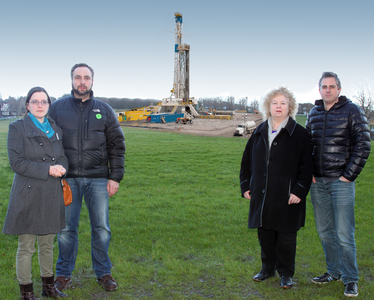1,000 signatures reached
To: London Borough of Lambeth
Ban Fracking in Lambeth

Following the news that the Government has issued a license permitting exploratory fracking in Streatham, we want Lambeth to join the growing number of Councils in England who are saying they will not be bribed by Cameron's offer to keep 100% of business taxes from fracking operations.
So far they include: Hampshire, Bath & North East Somerset, Somerset, Herefordshire, Cheshire East (which includes George Osborne's constituency of Tatton) & London Borough of Waltham Forest.
We want the Council to ban Fracking in Lambeth and instead support all forms of energy conservation and sustainable energy generation.
So far they include: Hampshire, Bath & North East Somerset, Somerset, Herefordshire, Cheshire East (which includes George Osborne's constituency of Tatton) & London Borough of Waltham Forest.
We want the Council to ban Fracking in Lambeth and instead support all forms of energy conservation and sustainable energy generation.
Why is this important?
Fracking is not the answer to our long term energy crisis. Shale gas is not a low-carbon alternative to other fossil fuels. Advocates say we should exploit shale gas because it has lower carbon emissions than other fossil fuels. However, this doesn't take into account the risk of methane escaping during exploration and production. Methane is a greenhouse gas which is 25% more potent than carbon dioxide.
If shale gas is burnt in the UK, it will increase the UK’s carbon emissions, increasing the likelihood of dangerous Climate Change.
As a nation, France has completely banned it.
Hydraulic fracturing, or “fracking”, is the process of drilling and injecting fluid into the ground at a high pressure in order to fracture shale rocks to release natural gas inside.
Each gas well requires:
An average of 400 tanker trucks to carry water and supplies to and from the site.
It takes 1-8 million gallons of water to complete each fracturing job.
The water brought in is mixed with sand and chemicals to create fracking fluid.
Approximately 40,000 gallons of chemicals are used in fracturing.
Up to 600 chemicals are used in fracking fluid, including known carcinogens and toxins such as… Ethylene Glycol, Radium, Methanol, Hydrochloric Acid, Formaldehyde etc etc.
The fracking fluid is then pressure injected 10,000 feet into the ground through a drilled pipeline.
CONTAMINATION:
During this process, methane gas and toxic chemicals leach out from the system and contaminate nearby groundwater. Methane concentrations are 17x higher in drinking-water wells near fracturing sites than in normal wells.
Contaminated well water is used for drinking water for nearby cities and towns.
There have been over 1,000 documented cases of water contamination next to areas of gas drilling as well as cases of sensory, respiratory, and neurological damage due to ingested contaminated water.
Only 30-50% of the fracturing fluid is recovered, the rest of the toxic fluid is left in the ground and is not biodegradable. The waste fluid is left in open air pits to evaporate, releasing harmful VOC’s (volatile organic compounds) into the atmosphere, creating contaminated air, acid rain, and ground level ozone. In the end, hydraulic fracking produces approximately 300,000 barrels of natural gas a day, but at the price of numerous environmental, safety, and health hazards.
Greenpeace have set up a website so you can find out if your home is in a fracking area. Just enter your postcode: http://www.wrongmove.org
If shale gas is burnt in the UK, it will increase the UK’s carbon emissions, increasing the likelihood of dangerous Climate Change.
As a nation, France has completely banned it.
Hydraulic fracturing, or “fracking”, is the process of drilling and injecting fluid into the ground at a high pressure in order to fracture shale rocks to release natural gas inside.
Each gas well requires:
An average of 400 tanker trucks to carry water and supplies to and from the site.
It takes 1-8 million gallons of water to complete each fracturing job.
The water brought in is mixed with sand and chemicals to create fracking fluid.
Approximately 40,000 gallons of chemicals are used in fracturing.
Up to 600 chemicals are used in fracking fluid, including known carcinogens and toxins such as… Ethylene Glycol, Radium, Methanol, Hydrochloric Acid, Formaldehyde etc etc.
The fracking fluid is then pressure injected 10,000 feet into the ground through a drilled pipeline.
CONTAMINATION:
During this process, methane gas and toxic chemicals leach out from the system and contaminate nearby groundwater. Methane concentrations are 17x higher in drinking-water wells near fracturing sites than in normal wells.
Contaminated well water is used for drinking water for nearby cities and towns.
There have been over 1,000 documented cases of water contamination next to areas of gas drilling as well as cases of sensory, respiratory, and neurological damage due to ingested contaminated water.
Only 30-50% of the fracturing fluid is recovered, the rest of the toxic fluid is left in the ground and is not biodegradable. The waste fluid is left in open air pits to evaporate, releasing harmful VOC’s (volatile organic compounds) into the atmosphere, creating contaminated air, acid rain, and ground level ozone. In the end, hydraulic fracking produces approximately 300,000 barrels of natural gas a day, but at the price of numerous environmental, safety, and health hazards.
Greenpeace have set up a website so you can find out if your home is in a fracking area. Just enter your postcode: http://www.wrongmove.org
How it will be delivered
Deliver in person.

